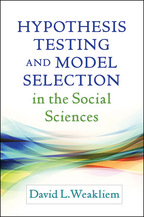Hypothesis Testing and Model Selection in the Social Sciences
David L. Weakliem
This title is part of the Methodology in the Social Sciences Series, edited by Todd D. Little, PhD.
“Weakliem offers a principled discussion of statistical methods for model selection and demonstrates them on applied problems in the social sciences. This thoughtful work should influence both statistical theory and social science practice.”
—Andrew Gelman, PhD, Department of Statistics, Columbia University
“One of the most difficult and complicated problems in any statistical analysis is model selection. In this comprehensive book, Weakliem provides a cogent and accessible presentation of existing thinking and methods. A 'must read' for any sociologist who is a serious applied quantitative researcher.”
—Christopher Winship, PhD, Diker–Tishman Professor of Sociology, Harvard University
“I especially appreciate this book's careful treatment of the philosophical arguments underlying hypothesis testing and the historical approaches that have been taken to the model selection problem. The question addressed here is not 'Which statistical test or approach should I use?' but rather, 'How can model specification, estimation, and statistical estimation advance what is known about a particular problem?' The book makes a convincing case for the utility of both traditional and Bayesian approaches—instead of calling for a Bayesian revolution—and leads quite logically to a number of ways that conventional practice can be improved. Rich bibliographies at the end of each chapter provide sources for further reading.”
—Phillip K. Wood, PhD, Department of Psychological Sciences, University of Missouri
Table of Contents
1. Hypothesis Testing and Model Selection1.1. Introduction
1.2. Standard Procedure of Hypothesis Testing
1.3. Model Selection
1.4. Purpose and Plan of the Book
2. Hypothesis Testing: Criticisms and Alternatives
2.1. Hypothesis Testing and Its Discontents
2.2. Uses of Hypothesis Tests
2.3. Criticisms of Conventional Hypothesis Testing
2.4. Implications of the Criticisms
2.5. Alternatives to Conventional Tests
2.6. Examples
2.7. Summary and Conclusions
Recommended Reading
3. The Classical Approach
3.1. Random Sampling and Classical Tests
3.2. Two Approaches to Hypothesis Tests
3.3. Confidence Intervals
3.4. Choosing a Significance Level
3.5. Comparison to Conventional Practice
3.6. Implications of Choosing an a-level
3.7. Other Kinds of Errors
3.8. Example of Choosing an a-level
3.9. Evaluation of Criticisms
3.10. Conclusions
Recommended Reading
4. Bayesian Hypothesis Tests
4.1. Bayes's Theorem
4.2. Bayesian Estimation
4.3. Bayes Factors
4.4. Bayesian Confidence Intervals and Bayes Factors
4.5. Approaches to Bayesian Hypothesis Testing
4.6. The Unit Information Prior
4.7. Limits on Bayes Factors
4.8. Bayes Factors for Multiple Parameters
4.9. Conclusions
Recommended Reading
5. The Akaike Information Criterion
5.1. Information
5.2. Prediction and Model Selection
5.3. The AIC
5.4. Consistency and Efficiency
5.5. Cross-Validation and the AIC
5.6. A Classical Perspective on the AIC
5.7. A Bayesian Perspective on the AIC
5.8. A General Class of Model Selection Criteria
5.9. Summary and Conclusions
Recommended Reading
6. Three-Way Decisions
6.1. Substantive and Statistical Hypotheses
6.2. Bayes Factors for Directional Hypotheses
6.3. Bayes Factors for Three-Way Decisions
6.4. Summary and Conclusions
Recommended Reading
7. Model Selection
7.1. Introduction
7.2. Bayesian Model Selection
7.3. The Value of Model Selection
7.4. The Risks of Model Selection
7.5. Examples of Model Selection
7.6. Conclusions
Recommended Reading
8. Hypothesis Tests
8.1. Hypothesis Tests and the Strength of Evidence
8.2. When Should Hypotheses Be Tested?
8.3. The Role of Hypothesis Tests
8.4. Overfitting
8.5. Hypothesis Tests and the Development of Theory
8.6. Conclusions
Recommended Reading
References
